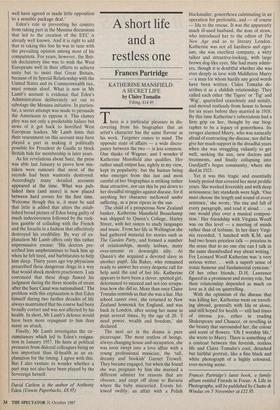A short life and a restless one
Frances Partridge
KATHERINE MANSFIELD: A SECRET LIFE by Claire Tomalin Viking, £14.95 There is a particular pleasure in dis- covering from his biographer that an artist's character has the same flavour as his work. Turgenev comes to mind. The opposite state of affairs — a wide discre- pancy between the two — is less common. One thinks of Wagner, and I wonder if Katherine Mansfield also qualifies. Her rather small output has, rightly in my view, kept its popularity; but the human being who emerges from this last and most careful of her biographies is striking rather than attractive, nor can this be put down to her dreadful struggles against disease, for if anything her character mellowed under suffering, as a pear ripens in the sun.
The child of a prosperous New Zealand banker, Katherine Mansfield Beauchamp was shipped to Queen's College, Harley Street, with her sisters to study languages and music. From her life in Wellington she had gathered material for stories such as The Garden Party, and formed a number of relationships, mostly lesbian, many over-intense or downright silly. At Queen's she acquired a devoted slave in another pupil, Ida Baker, who remained ready to answer her every despotic call for help until the end of her life. Katherine appears to have been a clever, spirited girl, determined to succeed and not too scrupu- lous how she did so. More than once Claire Tomalin reminds us that she was a liar. Her school career over, she returned to New Zealand homesick for England, and was back in London, after seeing her name in print several times, by the age of 20. 'I need power, wealth and freedom,' she declared.
The next act in the drama is pure picaresque. The most restless of beings, always changing house and occupation, she was soon swept into a love affair with a young professional musician, the 'tall, dreamy and bookish' Garnet Trowell. They became engaged, but when she found she was pregnant by him she married a different admirer for reasons that are obscure, and crept off alone to Bavaria where the baby miscarried. Events fol- lowed swiftly: an affair with a Polish blackmailer, gonorrhoea culminating in an operation for peritonitis, and — of course — Ida to the rescue. It was the apparently much ill-used husband, the man of straw, who introduced her to the editor of The New Age and so to literary London. Katherine was not all hardness and egot- ism; she was excellent company, a witty talker and attractive-looking, with large brown dog-like eyes. She had many admir- ers, though it is doubtful whether she was ever deeply in love with Middleton Murry a man for whom hardly any good words have been written. Claire Tomalin de- scribes it as a childish relationship. They called each other 'the Tigers' or 'Fig' and `Wig', quarrelled ceaselessly and noisily, and moved restlessly from house to house for six years before they married in 1918. By this time Katherine's tuberculosis had a firm grip on her, thought by our biog- rapher to be a legacy of gonorrhoea. Its ravages alarmed Murry, who was naturally afraid of contracting the disease, nor did he give her much support in the dreadful years when she was struggling valiantly to get well, seeking the sun, new doctors and treatments, and finally collapsing into Gurdjieff s bogus community, where she died in 1923.
Yet it was this tragic and essentially lonely period that covered her most prolific years. She worked feverishly and with deep seriousness; her standards were high. 'One must choose the length and sound of every sentence,' she wrote, 'the rise and fall of every paragraph, and read it aloud. . . as one would play over a musical composi- tion.' Her friendship with Virginia Woolf was on this level — a meeting of minds rather than of lesbians. In her diary Virgi- nia recorded, 'I lunched with K.M. and had two hours priceless talk — priceless in the sense that to no one else can I talk in the same disembodied way about writing.' For Leonard Woolf Katherine was 'a very serious writer. . . with a superb sense of ironic humour and fundamental cynicism.' Of her other friends, D.H. Lawrence figured in a prominent and stormy role, but their relationship depended as much on love as it did on quarrelling.
With the optimism of the disease that was killing her, Katherine went on travell- ing abroad, generally with Ida or alone, and still hoped for health — still had times of intense joy, either in reading Shakespeare and Chaucer, or revelling in the beauty that surrounded her, the colour and scent of flowers. 'Oh I worship life,' she wrote to Murry. There is something of a contrast between this feverish, restless life and Claire Tomalin's cool, detached but faithful portrait, like a fine black and white photograph of a highly coloured, ever-moving scene.
Frances Partridge's latest book, a family album entitled Friends in Focus: A Life in Photographs, will be published by Chatto & Windus on 5 November at f12.95.


































































 Previous page
Previous page